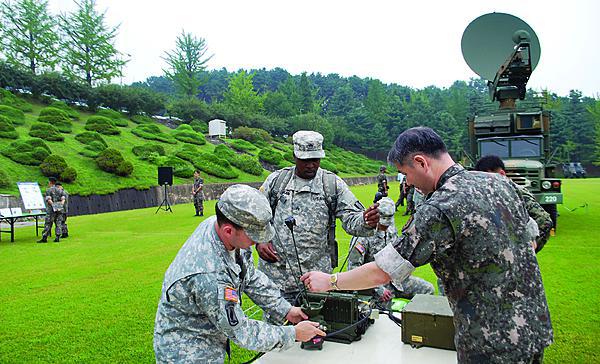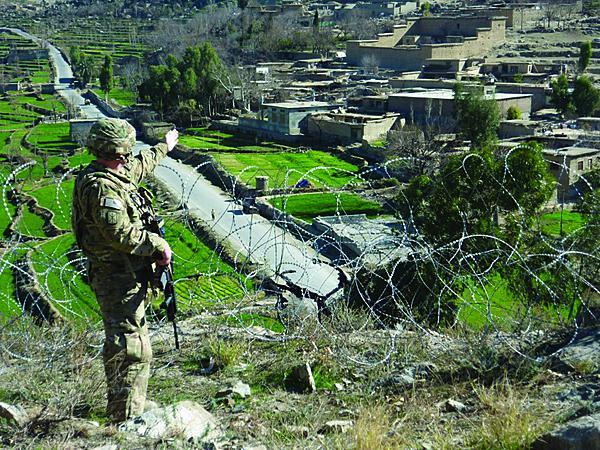U.S. Army Pacific Aims at Refreshing Its Networks
Legacy communications are underpinning new capabilities as the U.S. Army Pacific works to upgrade its systems before obsolescence defeats innovation. The new technologies and systems that will define U.S. military networking are beginning to reach across the Defense Department’s largest theater of operations. Yet, budgetary constraints are hindering implementation of new capabilities, and the existing systems that form the foundation of theater networking badly need upgrades before they begin to give out.
The U.S. Army Pacific (USARPAC) handles strategic communications within the region and provides support to other military services as well as to Korea and Japan. Its communications branch, the 311th Signal Command, must maintain current systems while adapting them to the force changes being wrought by the U.S. strategic defense pivot toward the Asia-Pacific region.
Yet the signal command must ensure effective communications and networking within the confines of Defense Department architectures and technologies. Even as the U.S. military presence undergoes changes in the region, upgrades and other improvements to the infrastructure must follow the department’s menu for information technologies.
“We’re not doing any home cooking here in the Pacific,” declares Maj. Gen. James T. Walton, USA, commanding general of the 311th Signal Command (Theater) and USARPAC G-6. “We’re not trying to develop any Pacific-unique solutions.”
The U.S. strategic defense pivot toward the Asia-Pacific region has not substantially changed the signal command’s mission or its operations. The Army is engaged to a greater degree than it had been over the past 10 years, Gen. Walton allows. Ensuring en route mission command communications continues to be one of the command’s top priorities for the vast region.
Currently, the signal command is focusing on adaptive communications for the diverse missions confronting the Army in that theater. This requires scalable and deployable communications packages that can support different sizes of mission command nodes. Gen. Walton notes that these nodes could range from units as small as an assessment team, which might be served simply by equipping them with Iridium phones, or as large as a full joint task force that requires a large and comprehensive communications capability.
Gen. Walton notes that these packages tend not to comprise new technologies. Most of the gear is off-the-shelf, and much of it has been used in Southwest Asia. Capabilities developed for special operations forces could serve Asia-Pacific needs, and many are under consideration. So, the signal command is examining solutions that currently exist, with existing programs of record the preferred solution, the general states.
“This is not a development initiative,” he emphasizes. “This is assessing what capability is currently available and then identifying the right solution and developing an acquisition and funding strategy.”
Overall, the Pacific pivot has made the 311th more of a focus theater signal command within the Army’s Network Enterprise Technology Command (NETCOM) global enterprise, the general offers. The 311th is better postured than it has been in the past to address the challenges in the Asia-Pacific region, he continues.
Greater changes come from geopolitical developments, especially in Korea. The divided peninsula has been a focal point over the past 60 years, and the perceived threat from North Korea tends to run in cycles. The past couple of years have been a period of heightened tension, Gen. Walton notes, but the increased emphasis on Korea has been driven by that area’s specific circumstances and not by the Pacific pivot. “That’s not a strategic shift,” he explains, “it’s an environmental or threat-driven shift that has caused us to focus on providing necessary support to the warfighters on the peninsula.”
Among the enterprise initiatives underway in the Pacific theater is the Joint Information Environment (JIE)-Korea (see page 26), which is designed to be a bridge to the Defense Department JIE. Gen. Walton states the 311th Signal Command is supporting JIE-Korea efforts as its own contribution to the overall JIE.
The Asia-Pacific region’s information infrastructure is aging significantly, the general observes. This includes both the warfighter support infrastructure and mission capabilities that increasingly are needed in the Asia-Pacific region. The threat is twofold: legacy assets increasingly are unable to support requirements, and some of them are so old replacement parts are difficult to obtain. These problems are complicated by the harsh weather found in the theater, ranging from subfreezing temperatures in Alaska to tropical heat and humidity in equatorial countries. Equipment and capabilities must be replaced in an atmosphere of declining budgetary resources.
This infrastructure has not seen any major investments over the past 10 years, as the command has been “a fiscal economy of force theater” over that time span. In this tight budget environment, the advantage of being a focus theater signal command may mean seeing fewer reductions, instead of enjoying the greater resource support that characterized previous eras. The general expects the Army’s new enterprise capabilities will help mitigate infrastructure and capability shortcomings.
With budgetary concerns being the command’s major challenge, Gen. Walton wants industry to work collaboratively on cost-effective, affordable solutions. “Our collaboration with industry in a fiscally constrained environment is the best thing that industry can help us with—it’s to understand how we can ensure we still can do the mission, recognizing that we’re going to have limited resources to do it,” he declares.
Facing tight resources, the signal command will need to make hard decisions, the general continues. While it does not have an overarching initiative, the command is identifying the most critical dimensions of its mission set to ensure they receive the proper focus. Conversely, the command may need to eliminate or degrade other areas that have less priority. These would become areas where the Army accepts risk, he offers.
A new factor in this capability challenge is the shrinking Army. By 2015, the Army is scheduled to reduce its force to 490,000. Gen. Walton does not foresee significant reductions in the Army’s signal structure in the Pacific, although signal formations may be reorganized.
One of the ongoing challenges facing communicators in the Asia-Pacific region involves its geopolitical nature. The United States has formal bilateral alliances with five countries, but it also partners with many others on an ad-hoc basis. Many of the countries willing to work with the U.S. military across a range of missions have long-standing cultural and political differences with their neighbors, which prevents the establishment of multinational alliances along European lines. As a result, coalition interoperability remains a major hurdle greater than joint interoperability.
Gen. Walton says that the signal command is adapting lessons learned in Afghanistan, particularly with the Afghan Mission Network (AMN). Some AMN aspects may be applicable to the Asia-Pacific theater.
Other cultural differences loom. The way the U.S. military services interoperate among themselves may be different for other nations, for example. Fiscal considerations also are an issue. The United States has made significant investments for improving interoperability among its own forces and with those of other nations, Gen. Walton notes. However, many other countries have not had the need to do so and thus lag in that realm.
Even with friendly, technologically-advanced countries, interoperability at the lower tactical levels can be difficult. The general points out that nations pursue their own procurement strategies, particularly with waveforms and spectrum. Most nations allocate spectrum differently, and this can create conflicts that silence communications or radar gear on military platforms. “Taking a long-term perspective, we can identify areas where we aren’t able to interoperate at the tactical level, and then over the long haul migrate toward respective solutions that different nations can procure and then field,” he suggests.
Given the nature of the Asia-Pacific region, U.S. forces can expect to be involved in multiple major humanitarian assistance/disaster relief (HADR) missions in any given year, the general offers. These efforts involve partnering with other nations as well as with nongovernmental organizations, academia and industry. Interoperating with groups that do not use classified networks requires having the full spectrum of capabilities to support many different scenarios, Gen. Walton points out.
Commercial off-the-shelf technology such as smartphones and tablets can serve as conduits for exchanging unclassified information, especially in an HADR scenario, the general allows. However, their use would be more difficult in other scenarios that require greater network security. No ongoing initiatives focus on using these capabilities in the Pacific theater, he avers.
Cyber is an inescapable focus, Gen. Walton states, and the signal command’s element in that challenge is to protect the network. Cyber is a major concern among partner nations, and the command is collaborating with them to build partner capacity and help improve the collective cyber perimeter. “No perimeter is any stronger than the weakest link or the weakest node,” he observes, adding that cybersecurity has created an opportunity for the signal command to establish, renew and strengthen relationships. Cybersecurity engagements have taken place in some of the many multinational Asia-Pacific exercises which the United States conducts. These engagements have proved to be invaluable even when conducted at the fully unclassified level, the general relates. “Cyber is an integrating theme across all that we do, and moreover it’s even an integrating theme across how we partner with other nations in the Pacific,” he emphasizes.
The command’s signaleers are well-suited for most cyber operations, Gen. Walton offers. The basic elements of signal—operate, maintain and defend the network—constitute the core of cyber operations. He emphasizes that the command has not renamed its signal soldiers cyber warriors—nor is it giving them special training or creating a separate cyber corps—but they are very involved in the cyber fight because what they do every day is fundamentally part of the cyber domain.






Comments